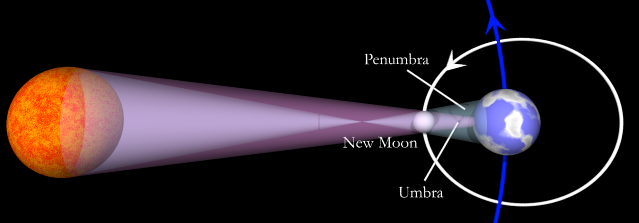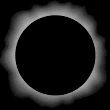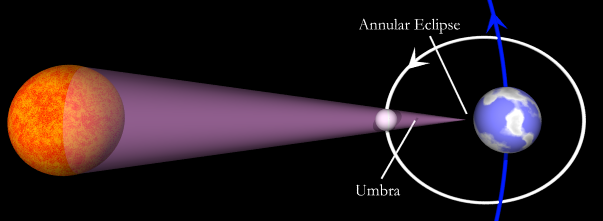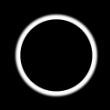All solar eclipses involve the
Moon passing between the
Earth and the Sun, and casting a shadow on the Earth. However, the
type of eclipse which can be seen from a given location depends on
whether the Moon passes directly, or only partly, between the Earth
and Sun; but also on where on Earth you stand to observe it, and on a
number of other factors.
This page attempts to explain how
solar eclipses work, and the different types of solar eclipse.
The diagrams here, by the way, are drawn to a wildly exaggerated
scale; they can not be drawn to a real scale, because the Solar System
is just too big! For example, the Sun is about 93 million miles away;
but the width of the shadow of a total eclipse on the Earth might be
just a few miles.
A Total Eclipse
A total solar eclipse is when the Sun is completely covered
by the Moon. This diagram illustrates in more detail what happens
during a total eclipse:
Here, the moon passes between the Earth and Sun (i.e. comes to a
New Moon) at a point in its
elliptical orbit when it is relatively close to the Earth. As it does
so, it casts a shadow. The
umbral part of the shadow (the
umbra) is the area where the Sun is totally obscured by the
Moon. During a total eclipse, the Moon is close enough to the Earth
that part of the umbra falls upon the Earth; in technical terms, we
say that its
magnitude is greater than or equal to 1.000.
People standing on those
parts of the Earth, within the Umbra, see the Sun's face completely
hidden by the Moon — a
total eclipse of the Sun.
The beautiful part of a total eclipse, though, it what is
not hidden: the Sun's faint
corona, and
solar prominences.
Partial Eclipses
A partial solar eclipse is when the Moon covers only part of
the Sun, taking a "bite" out of it.
Looking again at the diagram above, you will see that there is an
area, outside the umbra, where the Sun is only partly covered by the
Moon; this is known as the penumbra, and it covers a much
larger area of the Earth than the umbra. Looking at the tip of the
penumbra pointer, for example, you will notice that it can "see" the top
part of the Sun, but not the bottom part; the Moon is in the way. The
area of the Earth which falls within the penumbra sees a partial
eclipse of the Sun. Looking at it another way, we
say that a partial eclipse is an eclipse with a
magnitude less than 1.000.

Within the penumbra, the Sun is partly covered, and its light dimmed,
to varying degrees; people within the penumbra and close to the umbra
would see the Sun almost (but not quite) covered, whereas people on
the edge of the penumbra would see the Moon take just a little "bite"
out of the Sun, at most. During even a large partial eclipse, the
remaining crescent of the Sun is so intense (actually, just as intense
as on a normal, clear day) that it is
not safe to look at the
Sun directly, and in any case it would be impossible to see anything
other than the crescent Sun.
As you can see, every total eclipse is accompanied by a partial
eclipse falling on a larger area of the Earth, since the umbra is
always surrounded by the penumbra. However, it is quite possible for
the Moon's penumbral shadow to fall upon the Earth when the umbra
misses the Earth completely, and falls away into space. When that
happens, parts of the Earth see a partial eclipse, but there is no
total eclipse. This happens quite often.
It is important to bear in mind that when you are within a partial
eclipse, the photosphere —
the bright part of the Sun — is still visible. You should never look
at this directly, as it is always capable of causing permanent eye
damage, even when almost completely covered.
The Annular Eclipse
An annular eclipse occurs when the Moon covers the centre of
the Sun, but not its edges, leaving a ring (or annulus) of the
Sun visible around its edges. This image illustrates how an annular
eclipse can occur:
Here, the Moon in its elliptical orbit is farther from the Earth, and
the umbra is too short to reach the Earth. However, the Moon is
directly in front of the Sun, so the parts of the Earth underneath it
see a partial eclipse where the centre of the Sun, rather than a
"bite" at the side, is covered. This leaves a ring — an annulus —
of the Sun visible round the edges of the Moon. (An annulus is the
shape of a circle with its centre cut out.) Technically, this
is a
central eclipse with a magnitude less than 1.000.
People off to one side of the eclipse track fall under the penumbra
(not shown in this diagram, for simplicity), and see a normal partial
eclipse.
As with a partial eclipse, an annular
eclipse leaves a section of the Sun's
photosphere visible at all times,
so again it cannot safely be viewed with the naked eye.
The Hybrid Eclipse
A hybrid, or annular/total, eclipse is an eclipse
which is seen as annular by some parts of the
Earth, and total by others (and also as a
partial eclipse over a much larger area). This
image illustrates how a hybrid eclipse can occur:
Here, the Moon is just far enough from the Earth that the umbra
can't reach the "sides" of the Earth, so as the eclipse begins, the
western portions of the Earth see an annular eclipse as the day
begins. In the diagram, observers in the upper and lower parts of
the eclipse track will see an annular eclipse.
As the eclipse path moves on, the umbra has less far to travel to
reach the Earth, and is just long enough to reach the "centre"
(ie. the part most directly facing the Moon); so observers in the centre
of the eclipse track see a total eclipse. Such an eclipse would have
a magnitude greater than 1.000, since
the magnitude given for an eclipse represents the magnitude at maximum
eclipse; but during the ends of the eclipse, the magnitude is less than
1.000.
People standing near, but not in, the annular/total eclipse track,
would see a normal partial eclipse.
With the Moon that far from the Earth, the visible total eclipse
will be a pretty small eclipse — i.e. with a narrow track, and short
duration. For example, in the
hybrid eclipse of April 8 2005, the
total part of the eclipse
was visible for 42 seconds at its maximum point, and its track was no
more than 27km wide.
It Goes The Wrong Way!
So much for how eclipses happen — but one question that often
comes up is, why does the eclipse go from West to East, when the Sun
and Moon go the other way?
Well, the movement of the Moon — from East to West — is,
in fact, an illusion caused by the Earth's rotation. As a matter of
fact, the Moon orbits in the same direction that the Earth rotates;
anticlockwise, as seen from above the North pole. But whereas the
Earth takes just 24 hours to do one rotation, the Moon takes a month
to go round the Earth (actually, the Moon takes 27.32 days to
orbit the Earth).
This diagram illustrates the situation — but remember that it's not
even remotely to scale!
In other words, if the Earth was sitting still, the Moon would
cross the sky from West to East. It would take 14 days to cross from
horizon to horizon, and another 14 days to come around into view
again. But the Earth doesn't sit still — it rotates, every 24 hours,
which is significantly faster than this. It's like if you're driving
a car and overtake a jogger, they seem to be going backwards relative
to you; the Earth rotates faster than the Moon's orbit, so the Moon
seems to be going backwards, when it's actually going the same way.
So what happens to "fix" things during an eclipse? Well, the Moon
orbits the Earth once a month; but the distance that it travels in
that month is a whopping 2,415,256 km! This means that it's moving
really fast. By contrast, the Earth is a tiny 12,742 km across; so for
the Moon to cross in front of the Earth — for its shadow to cross the
Earth — doesn't take long at all; the Moon moves 12,742 km in just 3
hours. (The exact time for the eclipse to cross the Earth depends on
whether the Moon is crossing over the centre of the Earth or
off-centre, and on what part of its elliptical orbit the Moon is in.)
So the shadow zips across much faster than the Earth's rotation, which
makes its real direction apparent.
To put it another way, the Moon only has to cross a tiny part of
the sky — a small fraction of its total orbit — for its shadow to
cross the Earth completely. This means that for an eclipse, the
Moon's own "real" movement is the main cause of its movement; so the
shadow goes West-to-East.
It Changes Direction!
Astute readers have pointed out that some eclipses actually change
direction — the
total eclipse of November 23, 2003,
for example, goes
West-East and then changes to East-West, according to the co-ordinates of
the centre of the eclipse. (Thanks, Bill Lee!)
The reason for this is that this eclipse is very close to the
southern end of the Earth, and in fact wraps around it — but the
"southern end of the Earth" isn't the South Pole, because the South
Pole is tilted towards the Sun in November. In general, extreme
northern and southern eclipses can have odd behaviour like this.
The animation on the right illustrates the path of totality in this
eclipse, looking down at the South Pole; the centre of the total
eclipse is shown by a black cross, and the daytime side of the Earth
is shown illuminated. As you can see, the path of totality moves in a
straightforward way from West to East, but at an odd angle to the
lines of longitude; so technically, after 22:36 UT, its longitude
actually turns around and starts moving East-West.









